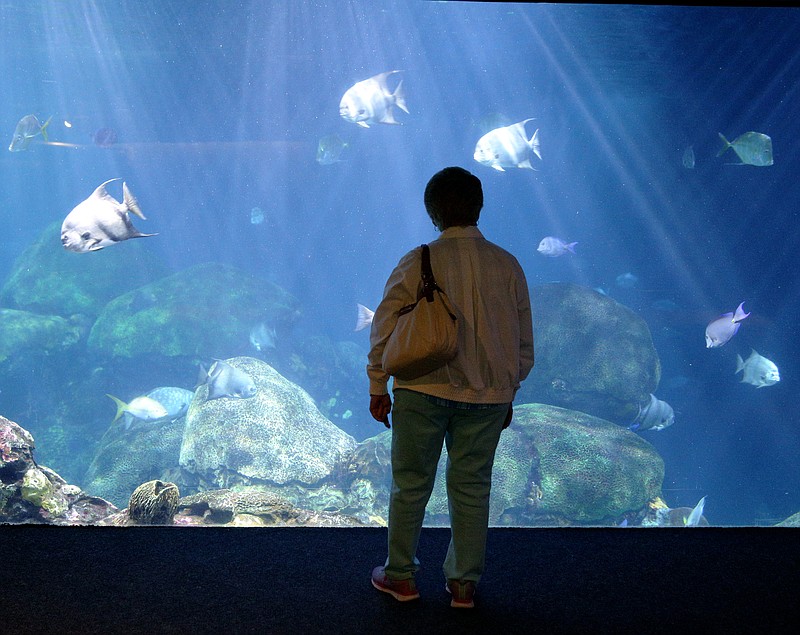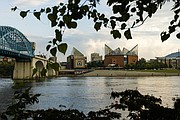Editor's note: This is part of an ongoing series commemorating the 150th anniversary of the Chattanooga Times Free Press. To read more, visit timesfreepress.com/150years.
"Aquarium Opens With A Splash," screamed the six-column headline across the front page of the afternoon Chattanooga News-Free Press on Friday, May 1, 1992, the day the Tennessee Aquarium opened.
"It's a keeper! Thousands applaud city's biggest catch" the morning Chattanooga Times said the next morning. Times reporter Carolyn Mitchell summed up the day downtown Chattanooga was reborn in her lead paragraph: "With children prancing down the street under flurries of shiny soap bubbles, Jack Lupton beamed at the festival scene and said, 'This is what it's all about.'"
The twin peaks that rest atop the two aquarium buildings at the end of Broad Street are a cornerstone of the city's transformation from a polluted industrial town on the Tennessee River to a destination for many looking to relocate. Lupton, the Coca-Cola magnate who died in 2010, is the cornerstone of the philanthropy that built the aquarium.

View our 150 years anniversary coverage
Yet, 27 years later, Kim White, president of the nonprofit River City Co., which focuses on downtown economic development, said some Chattanooga-area residents take the aquarium for granted.
"It's the foundation of the city for many reasons," she said. "There has been $5 billion in investment since it opened."
Jon Kinsey became the first businessman to serve as city mayor when he was elected in 1997; Bob Corker was the second in 2001. Neither was near the core of the team that built the aquarium, but both knew Lupton and were standing in the audience the day the aquarium opened.
"None of what happened downtown would have happened if it wasn't for the aquarium, I can promise you that," said Kinsey, a longtime real estate developer and civic leader. "Chattanooga is not Chattanooga without the aquarium, and the aquarium does not happen without Jack Lupton. You cannot overstate his impact."
Corker has an equally lofty perspective on the impact of the aquarium.
"It was the first physical structure that proved we were moving in the city and were going to change," he said. "It was an exclamation point at the time that was iconic." Thirteen years later, Corker would lead a successful community effort to finance and build the 21st Century Riverfront.
In 1992, the News-Free Press published on Sunday, and the coverage of the aquarium opening lasted seven days. The Sunday News-Free Press (50 cents, 12 sections) kicked off the coverage with a dedicated section on the aquarium. It continued on the front page every day.
The Times, (50 cents, four sections) was equally effusive in the days leading up to the opening. Editorial page editor Mike Loftin, writing for publisher Ruth Holmberg and under the headline "A Wonder on the River," said: "Most of all, the Tennessee Aquarium celebrates a vision, a stunning expression of faith in the community's future, a generosity of spirit and resources unmatched in recent history. Chattanooga is fortunate to be the beneficiary of those factors. We will be even more fortunate if we use the aquarium as a springboard for additional development, in which the vision and faith of others is a guiding force."
The two newspapers dedicated more than 25 pages of content to the opening.
On May 2, Times award-winning editorial cartoonist Bruce Plante drew a crowd of people standing in front of the aquarium holding a sign that read, "From the citizens of Chattanooga. Thank You Jack Lupton." Plante, now a syndicated cartoonist, drew himself in standing at the far right of the cartoon.
Reporter Mike Pare, now deputy business editor for the Chattanooga Times Free Press, has worked for a Chattanooga newspaper for 35 years. He was the lead reporter covering the aquarium opening.
Pare's story that Sunday captured the moment that three years of construction gave way to opening the doors. "Now," Pare wrote, quoting architect Peter Chermayeff, "it's up to the public to pass judgment on the building."
Like the aquarium itself, Cindy Todd and Jackson Andrews are 27 years older. They were working the aquarium opening; Todd was directing communications and Andrews was a member of the operations team.
Today, Todd is the vice president, chief marketing and communications officer and Andrews the chief operations officer. Their tenure at the aquarium is surpassed only by that of Peter Burman, the IT director who started in 1990.
Todd and Andrews have lived the maturation of a facility they both love along with the transformation of downtown Chattanooga.
"In the early days, it was all about being the economic engine that Chattanooga needed to turn the downtown around," Todd said. "But the role of education and conservation that has become so important was always there."
Andrews recalled Lupton convening a meeting in 1993 or '94.
"Mr. Lupton sat us down and said, 'What's next?'" Andrews said.
Andrews said the idea of expansion came back in 2002 with a decade of valuable experience. From its opening year attendance of 1.4 million, the aquarium had leveled off at around 1 million customers annually. Todd said they had fulfilled Lupton's mandate to "run the aquarium like a business" and were beginning to use their experience in business functions such as finance, human resources and marketing in contracts to help the Hunter Museum of American Art and the Creative Discovery Museum, which opened in 1995.
Yet, the aquarium business plan was altered in 2001 when Home Depot co-founder Bernard Marcus announced the building of the Georgia Aquarium in Atlanta.
"The first building was dark and more like an adult exhibit," said Andrews of the original 130,000-square-foot building. "We wanted something done with the space that was kid-friendly, more hands-on. We wanted an experience that maintained our high level of quality and a place where you could look out and see the river and mountains."
The result of that planning was the 2005 addition of the second aquarium, Ocean Journey, which became part of Corker's 21st Century Waterfront development. The 60,000-square-foot, $30 million facility opened six months before the 550,000-square-foot Georgia Aquarium.
Todd and the aquarium adjusted to the competition that came from Atlanta and later in 2013 from Ripley's Aquarium of the Smokies in Gatlinburg, Tennessee.
Attendance dropped to 640,000 in 2006, the year after Ocean Journey opened. The aquarium was not immune from the recession of 2008 and coming out of the recession was the opening of the Gatlinburg aquarium. Slowly, attendance grew, and 770,000 visitors passed through in 2018. As it did the first year it opened, the aquarium draws more visitors annually than any other attraction in the Chattanooga region.
"We had aquariums on both sides of us, so the competition was something," Todd said. "The people on the leadership team knew that we had to stay focused on the quality of our experience and maintain the high level of customer satisfaction we had achieved."
The aquarium employs 175 full-time workers, 93 part-time and many seasonal employees. It operates on a $25 million annual budget with 70% of the funds coming from admissions and retail. It receives 7 percent of its revenue from contributions, a number Todd believe the aquarium will increase in the years ahead. It has reinvested profits to maintain the aquarium, such as the current need to replace the main elevator visitors ride to the top of the aquarium. It will cost $600,000 to replace.
"Jack Lupton didn't want us fundraising," Andrews said. "He wanted us running the aquarium."
With no more room to expand, Todd and Andrews believe the aquarium's future celebrity will come equally from the established quality of the exhibits and its decades of work in aquatic conservation.
The Tennessee Aquarium Conservation Institute, the only freshwater science center in the Southeast, was formed in 1996 and resides in a 14,000-square-foot, $4.5 million facility on the campus of Baylor School.
A sign with a map inside the institute says, "Did you know the southeastern United States is a biodiversity hotspot?" Chattanooga sits in the middle of the map.
"Being the voice of freshwater is significant, huge," Todd said. "We have to keep the aquarium strong because that is what funds the conservation and education, mission-critical work. I think people will look at us a little differently down the road because of the difference we are making in conservation and freshwater. People demand conservation today, and that is our passion and drive."
Todd said the most significant day of her time at the aquarium was not opening day, even though she said the "pressure to stage an event worthy of the aquarium" weighed heavy. She points to the day first-year attendance hit 1.4 million in April 1993.
"Jack Lupton said, 'How'd we do that!''' Todd said. "I was proud opening but when we did 1.4 million, I knew what the aquarium was going to do for Chattanooga."
The judgment Pare wrote about May 1, 1992, is documentable today. More than 26 million people have passed through the aquarium. TripAdvisor 2018 Travelers' Choice list ranks the Tennessee Aquarium as one of the 10 best in the world. Its dedication to aquatic conservation from its beginnings has led to it being recognized as a leader in aquatic biodiversity. It maintains the highest level of documented customer satisfaction in the country and has generated $3.5 billion in economic impact since its opening.
A "Splash" and a "Keeper," the newspaper headlines said.
Indeed.
Contact Davis Lundy at davislundy@aol.com.

